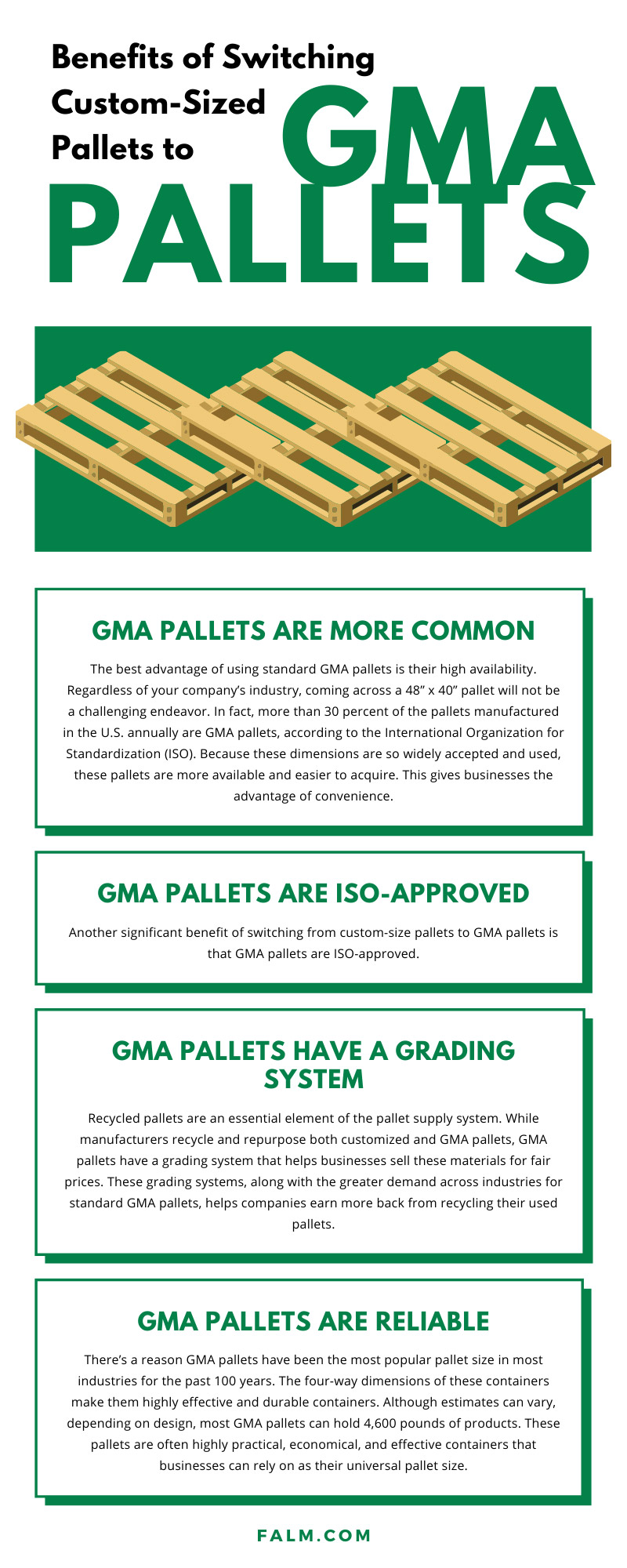- By falm
- November 28, 2021
- Buying Pallets
When manufacturers pay to acquire recycled pallets or build new ones, size is a crucial consideration. The size of a pallet will affect the availability, price, and building process of these containers for businesses.
As a reference point, the Grocery Manufacturers Association, or GMA, has determined that the standard size of pallets is 48” x 40”.
However, businesses may also use different dimension specifications for pallets, such as 42” x 42” or 48” x 48”. These custom dimensions are common when companies have concerns about the fragility of their merchandise, the size of their stock, or the transportation of their products.
Many customizations are possible regarding pallet size and design. However, sometimes, these alterations can ultimately limit a business’s resources and opportunities. Does your business need guidance in choosing the size for its pallets? Learn more about the benefits of switching custom-sized pallets to GMA pallets in the article below.
GMA Pallets Are More Common
The best advantage of using standard GMA pallets is their high availability. Regardless of your company’s industry, coming across a 48” x 40” pallet will not be a challenging endeavor. In fact, more than 30 percent of the pallets manufactured in the U.S. annually are GMA pallets, according to the International Organization for Standardization (ISO).
Because these dimensions are so widely accepted and used, these pallets are more available and easier to acquire. This gives businesses the advantage of convenience.
What Industries Use GMA Pallets the Most?
The popularity of these pallets also makes them appeal to a broader range of industries. For example, according to the International Organization for Standardization, GMA pallets were ranked as the most manufactured pallet size used by the grocery industry in North America.
The popularity of these pallets is not incredibly unsurprising, considering that their dimensions have been in use for over a hundred years. The GMA first created the standards for 48” x 40” pallets in 1908 to improve the quality of the food manufacturing process. Since then, GMA pallets have continued to become more and more available and established within most warehouse industries.
Why Are Custom Pallets Less Available?
When businesses need custom-sized pallets, these dimensions are not as readily available. Therefore, manufacturers either build new pallets with the necessary size specifications or acquire recycled pallets in the customized size that they can repair. While size is not the only factor to consider when buying or manufacturing pallets, businesses should consider how the higher availability of GMA pallets could benefit their distribution.
GMA Pallets Are ISO-Approved
Another significant benefit of switching from custom-size pallets to GMA pallets is that GMA pallets are ISO-approved.
What Is the ISO, and What Does It Do?
The ISO enforces several regulations for the pallet manufacturing process. These regulations provide detailed requirements for building and handling pallets. However, it’s important to note that the ISO is not a governmental foundation. Instead, this independent organization has a global network of 165 national bodies.
Members of the ISO work together to ensure that shipped and received items meet international standards. When pallets do not meet ISO standards, these containers may face issues with crossing borders into new countries. If businesses attempt to use pallets that do not meet ISO specifications and these containers are not accepted at international borders, the ramifications can be quite disastrous.
If businesses decide to manufacture custom-sized pallets, it’s vital that they carefully consult the ISO standards to prevent issues when importing and exporting products.
GMA Pallets Have a Grading System
Recycled pallets are an essential element of the pallet supply system. While manufacturers recycle and repurpose both customized and GMA pallets, GMA pallets have a grading system that helps businesses sell these materials for fair prices. These grading systems, along with the greater demand across industries for standard GMA pallets, helps companies earn more back from recycling their used pallets.
Grading Systems for GMA Pallets
- AAA (premium grade)
- A (standard)
- B (visible damage to the stringer)
Check out our website’s recycled pallet grade matrix to examine this grading system more closely.
Recycling Custom Pallets
GMA pallets are often recycled two or three times before these materials require more labor-intensive effort. Unfortunately, customized pallets often have fewer life cycles before they need extensive repairs, which can lower their value and cost.
GMA Pallets Are Reliable
There’s a reason GMA pallets have been the most popular pallet size in most industries for the past 100 years. The four-way dimensions of these containers make them highly effective and durable containers. Although estimates can vary, depending on design, most GMA pallets can hold 4,600 pounds of products.
Manufacturers know that these GMA pallets can hold large amounts of merchandise with less need to rearrange warehouse space. These pallets are often highly practical, economical, and effective containers that businesses can rely on as their universal pallet size.
There are tons of factors to consider when choosing a size for your pallets. Depending on your industry, your products, your mode of transportation, and your budget, specific pallet sizes may appeal more to your company’s needs.
However, we recommend reviewing our guide on the benefits of switching from custom-sized pallets to GMA pallets. Studying these pallets more closely may help your business reap the advantages of using GMA pallet sizes.
These 48” x 40” dimensions can hold large amounts of products with less wear and damage, and pallet users worldwide use them universally. If you have any doubts about the success or effectiveness of these containers, simply look at their 100-year history as the number one pallet size in the grocery industry.
Before ordering or manufacturing custom pallets, consider some of the benefits you may be missing out on by not using GMA pallets. Investing time to compare how the different pallet sizes will affect your business will be instrumental to your company’s success.
Here at First Alliance Logistics Management, we provide pallet solutions and resources for businesses and manufacturers. Do you have questions about buying or selling pallets? Need help with your company’s pallet management? Want advice when speaking to pallet vendors? We’ve got you covered. For information about our services and our team of experts, check out our website today.


